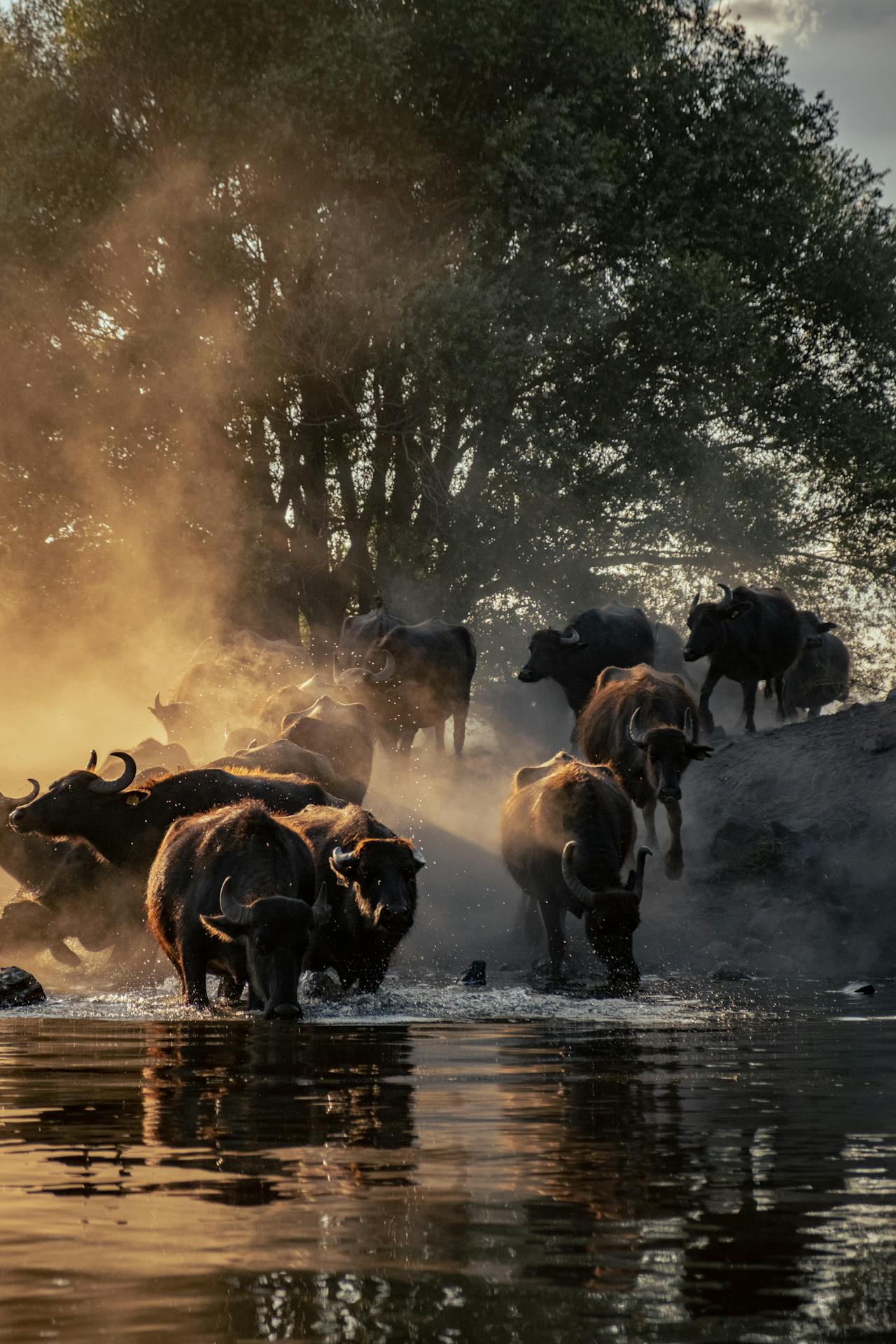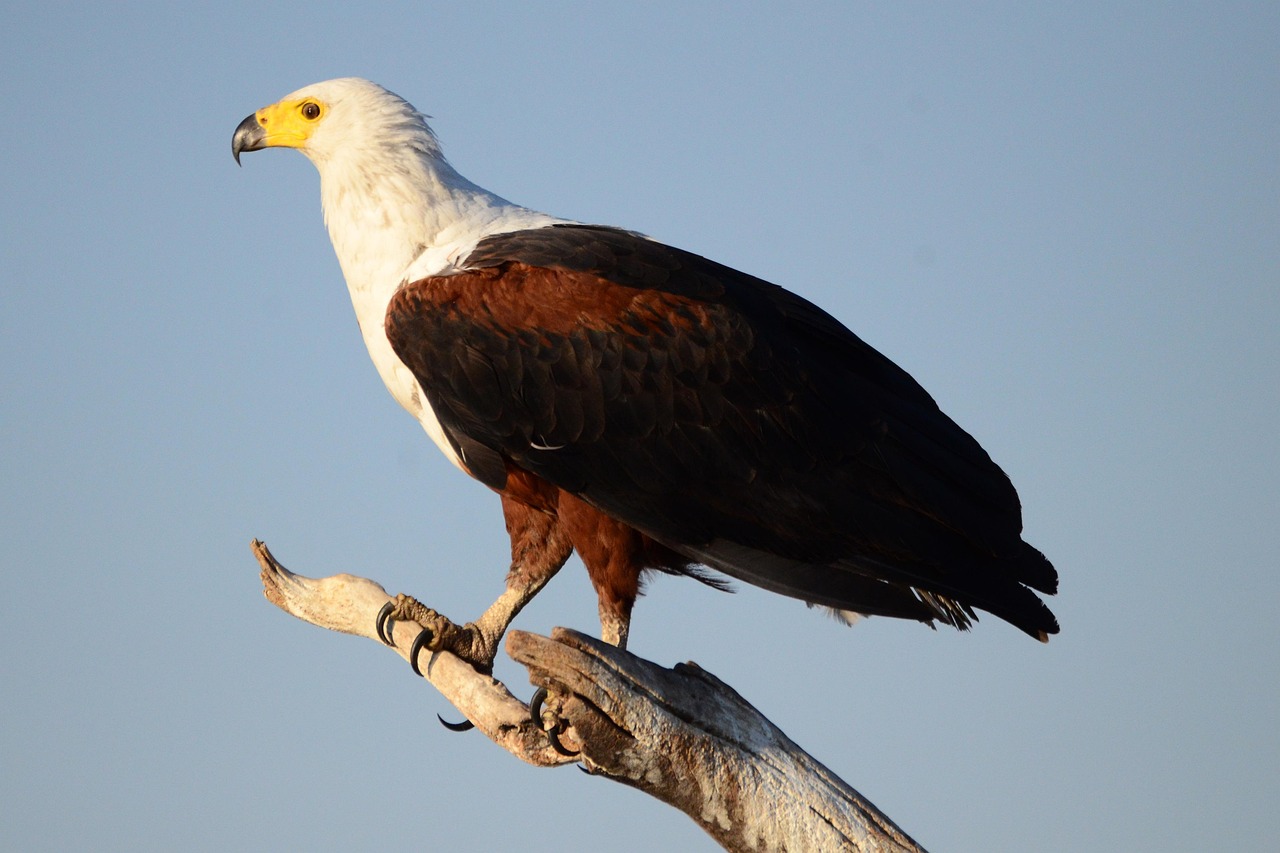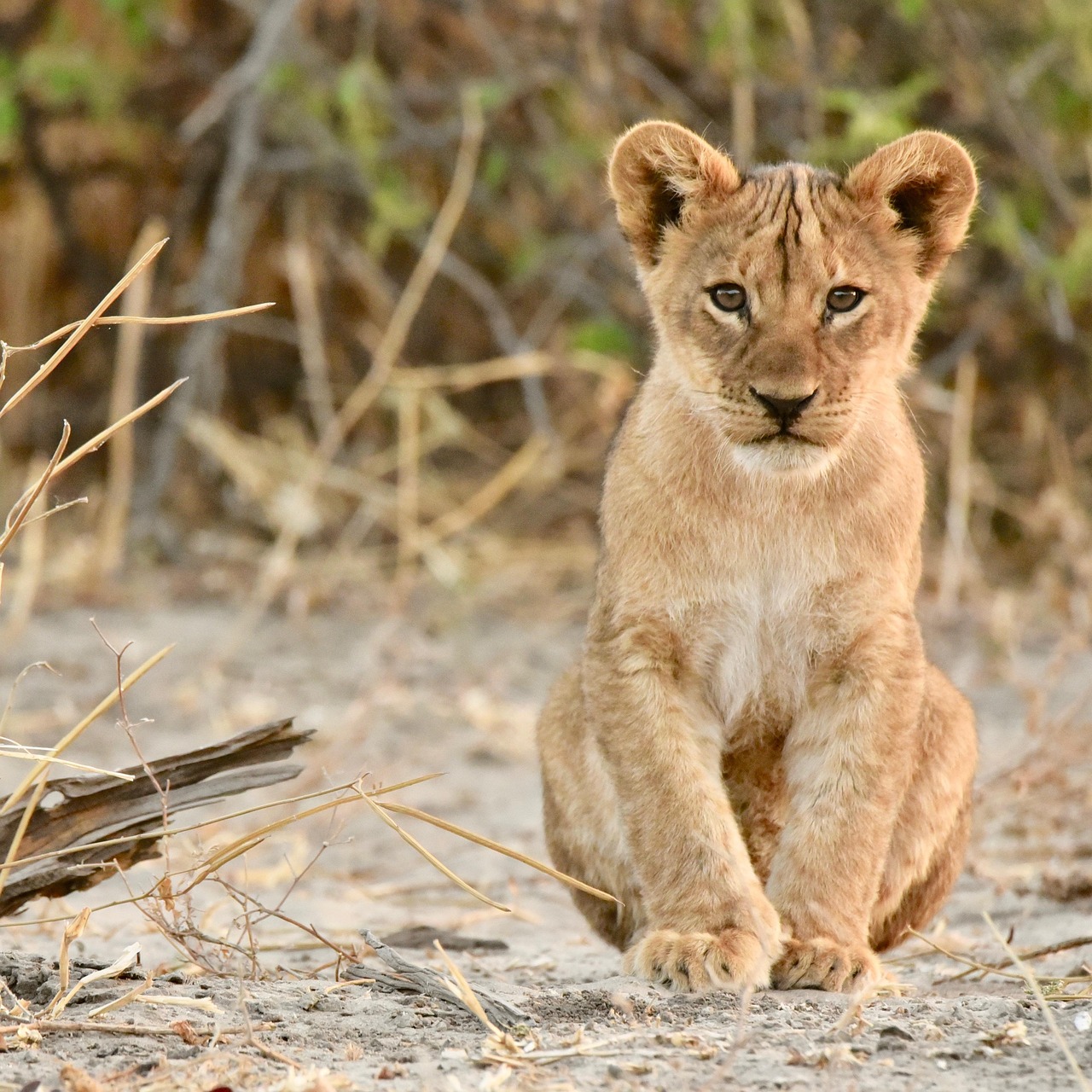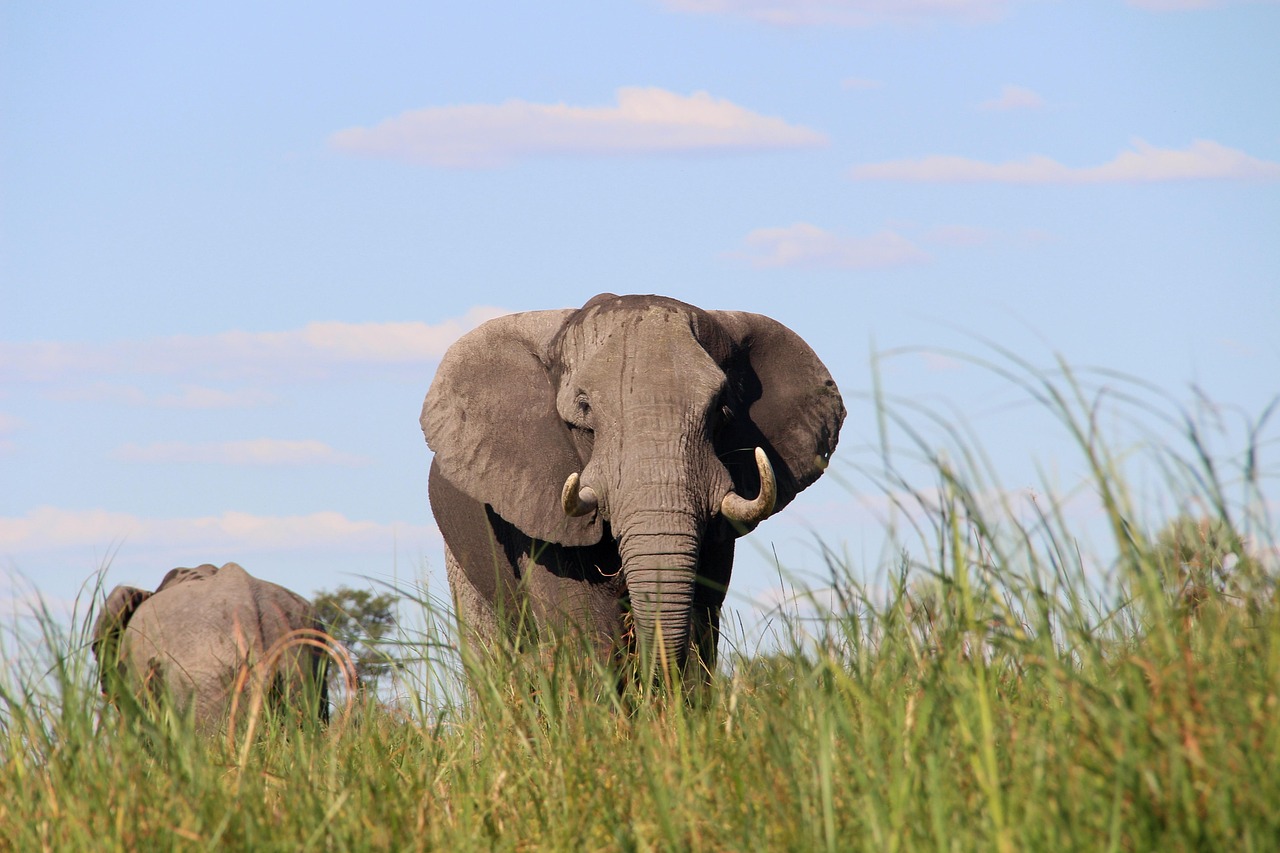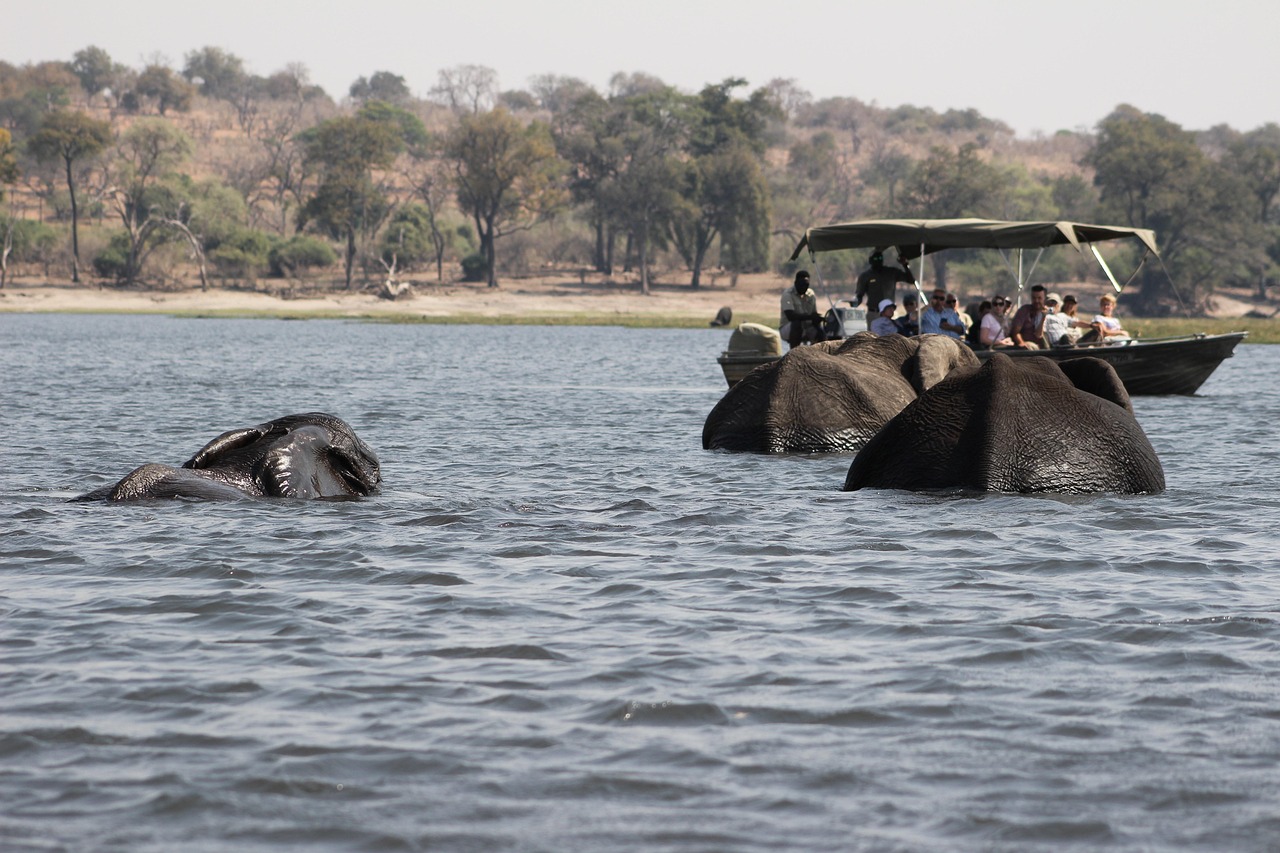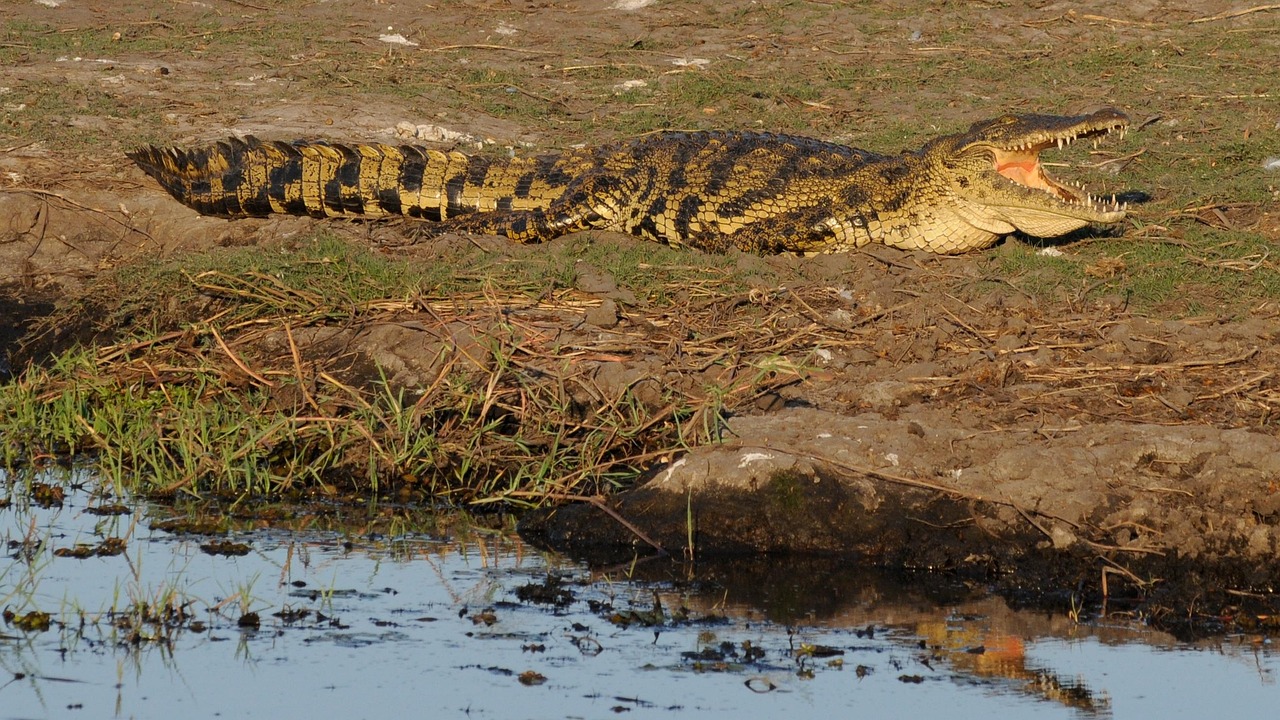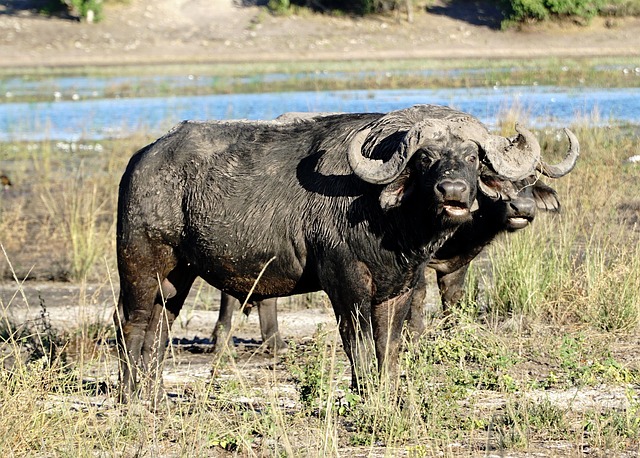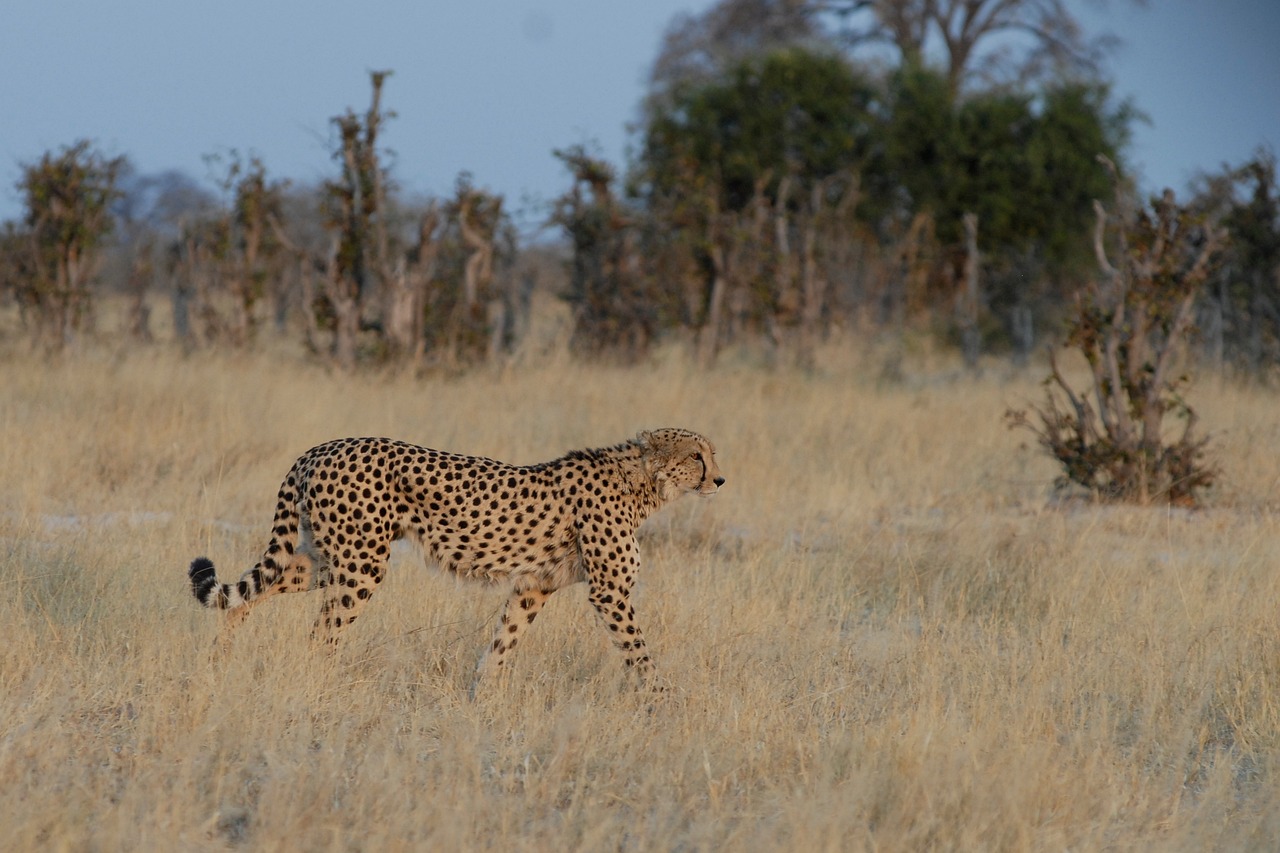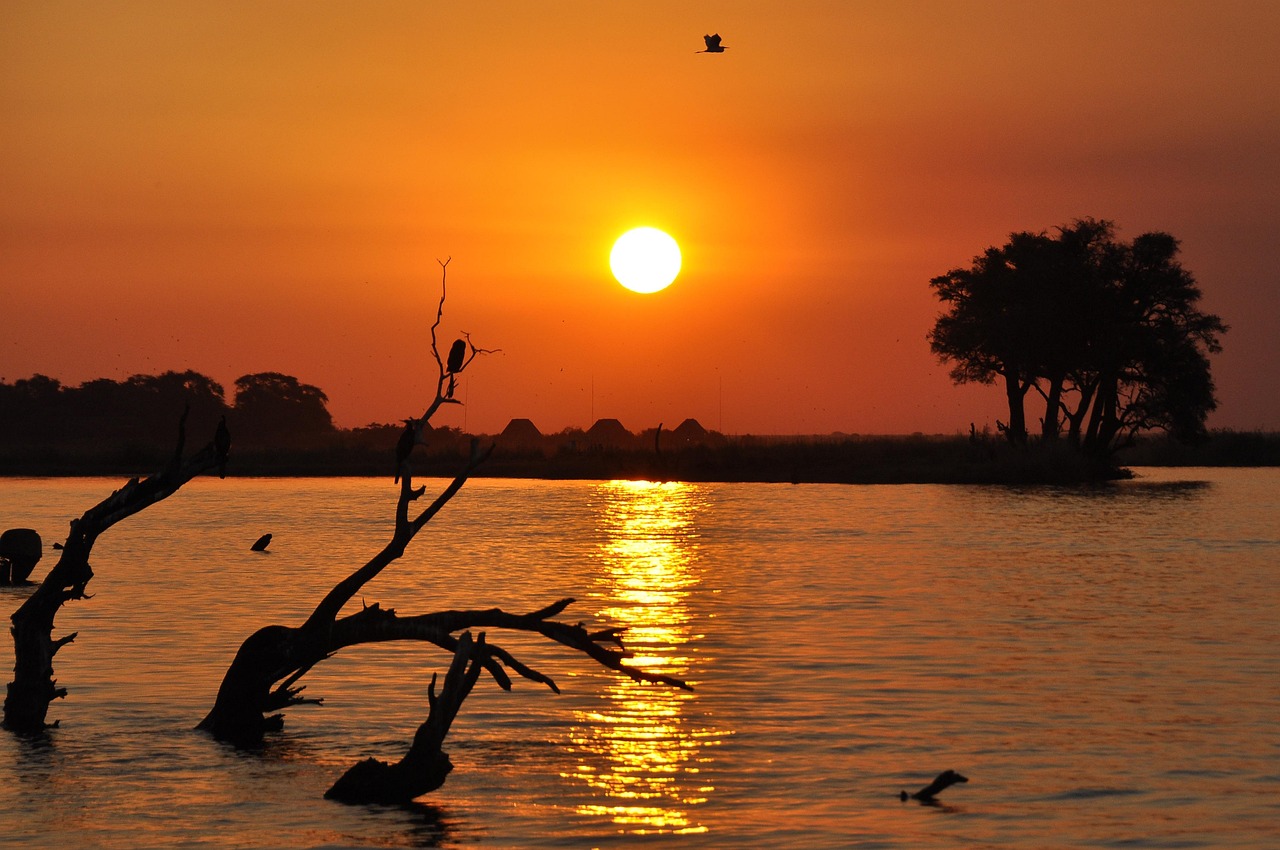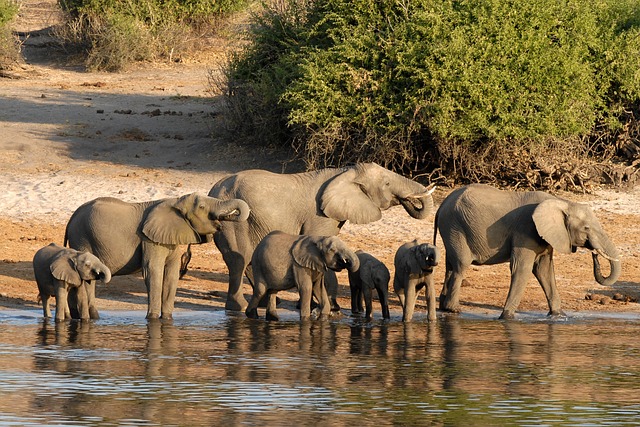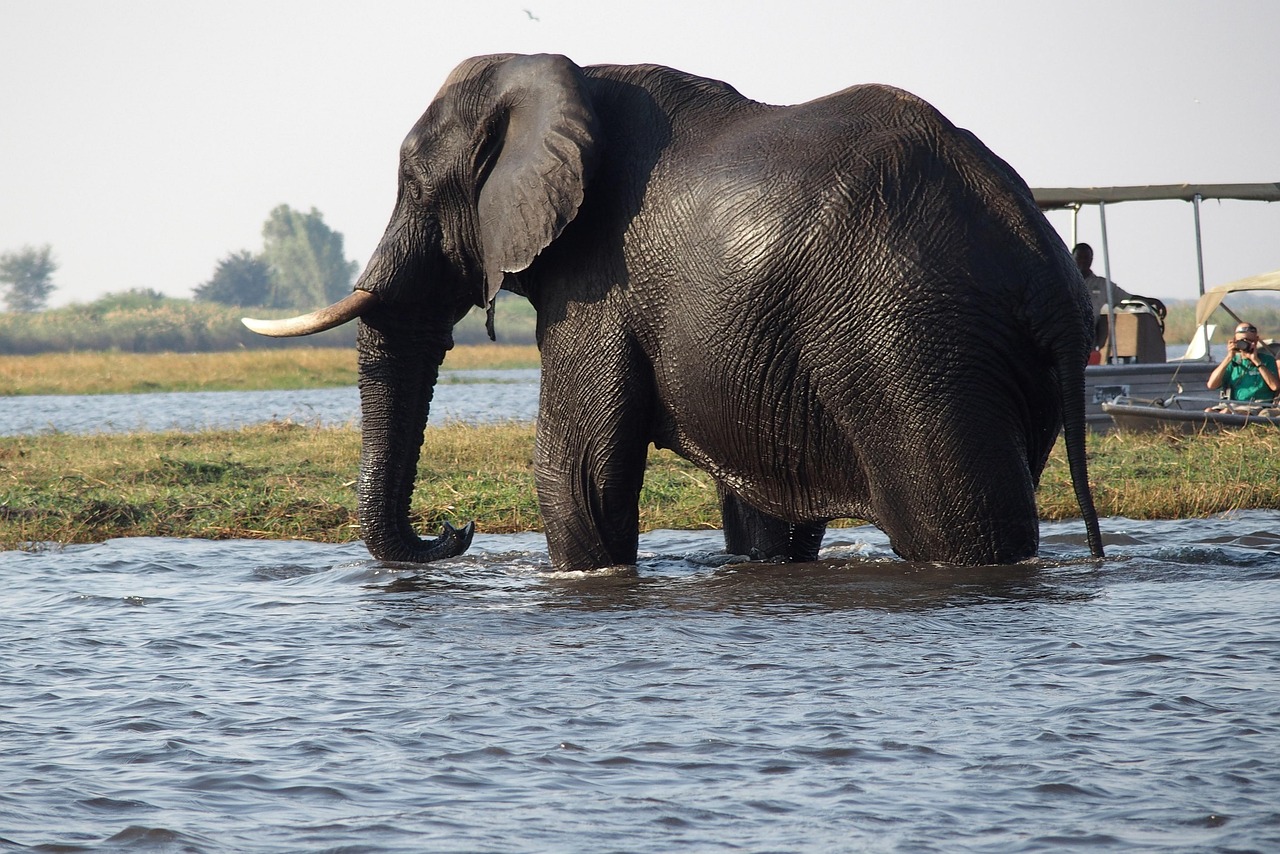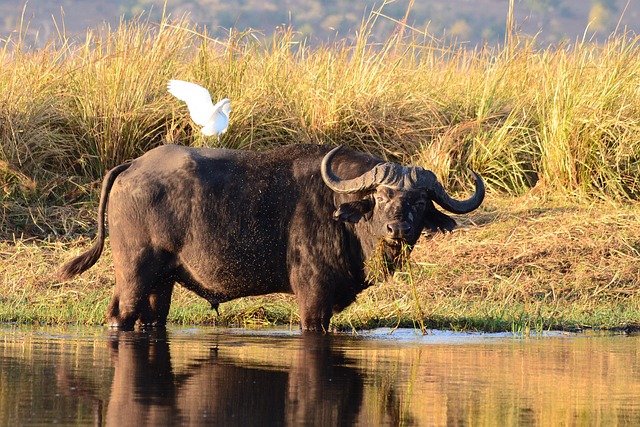
Chobe Safari Region
Everything you need to know about the Chobe Safari Region. A complete travel guide.Chobe Safari Region (Botswana)
Overview
A Complete Travel Guide To The Chobe Safari Region.
Everything you need to know before going on a safari to the Chobe Safari Region.
Chobe Safari Region centres on Chobe National Park, Botswana’s first national park, famed for its exceptionally dense wildlife—huge herds of African bush elephants, buffalo, lions and abundant birdlife. Spanning nearly 11,700 km², it comprises four distinct zones—Chobe Riverfront, Savute, Linyanti, and Nogatsaa—each offering varied habitats and wildlife dynamics.
Visitors arrive via Kasane, the primary gateway near the park’s northeast, with access by road or Kasane Airport, often combining Chobe with neighbouring Mokoro-based visits or Victoria Falls itineraries. A key draw is the high density of elephant families gathering along the Chobe River during the dry season, offering outstanding game viewing by boat safari and vehicle-based drives. The riverfront area is especially active between May and October.
Chobe also distinguishes itself through initiatives like the Chobe Angels, Botswana’s first all-women guiding team from Chobe Game Lodge, symbolising both conservation and community empowerment.
Explore Chobe Safari Region Below:
Explore Other Regions
Continue your safari planning journey across Africa’s top safari regions
Not sure if Chobe Safari Region is your perfect fit? Click below to explore and compare other safari regions.
Safety
Everything you need to know about safety in the Chobe Safari Region
Botswana and the Chobe Safari Region are widely considered safe and politically stable. Most travellers feel secure in both urban areas like Kasane and during guided game-viewing activities in Chobe National Park.
Expert tip: Always follow local advice and your guide’s instructions—especially at lodges and on safari—to stay safe around wildlife and in unfamiliar settings.
A Deeper Understanding Of Safety In the Chobe Safari Region
Botswana ranks among the safest countries in Africa, known for its political stability, low crime rate, and welcoming locals. While organised lodge-based and guided safaris in areas like Chobe National Park pose minimal safety risks, caution should still be exercised in urban centres such as Kasane and during self-drive trips.
In towns, petty crime—such as pickpocketing or opportunistic theft—can occur, particularly in markets, airports, and traffic stops. Most incidents are non-violent, but incidents like vehicle break-ins and grab thefts from traffic lights have happened. Keep valuables secured, avoid flaunting expensive items, and use licensed taxis after dark.
Wildlife safety is central to visiting Chobe. National parks and private reserves are unfenced, and wildlife may roam freely into camp areas. Never exit your vehicle unless permitted, and always obey your guide or lodge safety briefing. Lodges may escort guests at night and prohibit solo movements after dusk due to roaming animals.
Road safety remains a concern in remote regions. While main roads are generally well maintained, passing livestock or wildlife is common, especially at dawn/dusk. Night driving is discouraged due to poor lighting, road conditions, and the risk of wildlife accidents. For self-drive safaris, drive defensively, carry extra fuel and water, and familiarise yourself with emergency contacts.
Emergency medical services are available, though rural access may involve air evacuation via providers like Okavango Air Rescue. Travel insurance that covers evacuation is strongly recommended.
Malaria
Everything you need to know about malaria in the Chobe Safari Region
The Chobe Safari Region falls within a malaria zone, with high risk during the rainy season. During the dry months, risk drops to moderate, but protection is still advised. Visitors should plan antimalarial prophylaxis and bite prevention accordingly.
- Malaria Area: Yes
- Malaria Risk Level in Chobe Safari Region: 🔴 High
- Use the following link to find malaria and vaccination information for Chobe Safari Region: https://skyteam.traveldoc.aero/
Expert tip: Discuss antimalarial medication with your travel clinic at least 4–6 weeks before departure, and continue bite prevention from dusk till dawn.
A Deeper Understanding Of Malaria In the Chobe Safari Region
As part of northern Botswana, the Chobe Safari Region is considered high risk for malaria. From November to May/June, the rainy season enables extensive mosquito breeding—particularly Anopheles species transmitting Plasmodium falciparum. During this period, antimalarial prophylaxis is strongly recommended, alongside full-spectrum bite prevention.
In the dry winter months (June to August), mosquito activity declines sharply. The risk is reduced to moderate, but preventive measures remain essential, especially around riverfront and wetland zones near Kasane and Chobe National Park. All travellers, especially families, older guests, and immunocompromised individuals, should consult a travel health provider for personal guidance. Seasonal risk differences also mean those visiting during the rainy season should be more vigilant.
Malaria Risk by Month in Chobe Safari Region
🟢 Malaria Free, 🟡 Low Risk Of Malaria, 🟠 Medium Risk Of Malaria, 🔴 High Risk Of Malaria
| Month | Risk |
|---|---|
| January | 🔴 High Risk Of Malaria |
| February | 🔴 High Risk Of Malaria |
| March | 🔴 High Risk Of Malaria |
| April | 🔴 High Risk Of Malaria |
| May | 🔴 High Risk Of Malaria |
| June | 🟡 Low Risk Of Malaria |
| July | 🟡 Low Risk Of Malaria |
| August | 🟡 Low Risk Of Malaria |
| September | 🔴 High Risk Of Malaria |
| October | 🔴 High Risk Of Malaria |
| November | 🔴 High Risk Of Malaria |
| December | 🔴 High Risk Of Malaria |
Weather and climate
Everything you need to know about weather and climate in the Chobe Safari Region
Chobe Safari Region has a pronounced wet summer (November to March) with warm, humid conditions and a hot, dry winter season (April to October). Dry winter months bring clear skies and cooler mornings, ideal for wildlife viewing.
Seasonal Breakdown:
- Summer: November to March sees average highs of 32–36 °C (90–97 °F), lows of 19–24 °C (66–75 °F), with heavy seasonal rains (100–150 mm/month or 4–6 in), particularly December to February.
- Winter: April to October brings dry weather; average highs of 26–30 °C (79–86 °F), lows drop to 10–15 °C (50–59 °F) in June–July. Rainfall falls below 20 mm/month (<1 in), with clear, sunny days.
Expert tip: Plan early‑morning game drives during winter months with layers—mornings can feel cold, but midday is dry and comfortable.
A Deeper Understanding Of Weather And Climate In the Chobe Safari Region
The climate in Chobe aligns with northern Botswana’s semi‑arid subtropical pattern, marked by a short wet season (November–March) and a long dry season (April–October).
During the wet season, rains are often heavy but seasonal, with afternoon thunderstorms, high humidity (up to 80 %), and lush vegetation. Wildlife may disperse widely, but riverfront areas remain active. Summer months bring warmer nights and occasional flight disruptions due to storms.
From April onward, conditions become dry and clear. Days are hot, nights cool. June and July offer the coolest mornings, often around 10 °C (50 °F), improving wildlife visibility as animals concentrate around water sources. September and October heat up rapidly, with temperatures peaking near 36 °C (97 °F).
Peak safari conditions typically fall between June and September, when dry conditions, clear skies, and moderate warmth enhance game viewing. Those preferring greenery, birdlife, and fewer tourists may find January–April appealing, but expect higher humidity and occasional rainfall.
Regional microclimates are minor—areas near the Chobe and Linyanti rivers stay cooler and marginally wetter than hinterland zones. Boat safaris are enjoyable in winter, when breezes on the river offer relief from midday heat.
Table representing weather and climate in Chobe Safari Region by month
🟢 Excellent weather | 🟡 Fair weather | 🟠 Hot or rainy conditions | 🔴 Unfavourable travel period
| Month | Avg Low (°C/°F) | Average High (°C/°F) | Precipitation (%) | Rainfall (mm/in) | Rainy Days (Avg) | Humidity (%) | UV Index |
|---|---|---|---|---|---|---|---|
| January | 22 °C (72 °F) | 32 °C (90 °F) | 🟠 | ~120 mm / 4.7 in | ~12 | 70 % | High |
| February | 22 °C (72 °F) | 31 °C (88 °F) | 🟠 | ~110 mm / 4.3 in | ~11 | 70 % | High |
| March | 19 °C (66 °F) | 31 °C (88 °F) | 🟠 | ~60 mm / 2.4 in | ~8 | ~65 % | High |
| April | 17 °C (63 °F) | 29 °C (84 °F) | 🟡 | ~30 mm / 1.2 in | ~6 | ~55 % | High |
| May | 13 °C (55 °F) | 26 °C (79 °F) | 🟡 | ~10 mm / 0.4 in | ~2 | ~40 % | High |
| June | 10 °C (50 °F) | 26 °C (79 °F) | 🟡 | ~5 mm / 0.2 in | ~1 | ~35 % | Moderate |
| July | 10 °C (50 °F) | 27 °C (80 °F) | 🟡 | ~2 mm / 0.1 in | 0 | ~30 % | Moderate |
| August | 12 °C (54 °F) | 28 °C (82 °F) | 🟡 | ~5 mm / 0.2 in | ~1 | ~35 % | High |
| September | 16 °C (61 °F) | 35 °C (95 °F) | 🟠 | ~10 mm / 0.4 in | ~2 | ~25 % | High |
| October | 20 °C (68 °F) | 36 °C (97 °F) | 🟠 | ~30 mm / 1.2 in | ~4 | ~30 % | High |
| November | 21 °C (70 °F) | 35 °C (95 °F) | 🟠 | ~80 mm / 3.1 in | ~8 | ~50 % | High |
| December | 21 °C (70 °F) | 34 °C (93 °F) | 🟠 | ~100 mm / 3.9 in | ~10 | ~65 % | High |
When To Go
Everything you need to know about the best time to visit the Chobe Safari Region:
The optimal time for a safari in the Chobe Safari Region is from May to October, during the dry season. This period offers excellent wildlife viewing as animals congregate around water sources. The wet season, from November to April, brings lush landscapes and vibrant birdlife. However, wildlife viewing can be more challenging due to dense vegetation.
When To Go | Jan | Feb | March | Apr | May | Jun | Jul | Aug | Sep | Oct | Nov | Dec |
= Excellent = Good = Fair = Poor
- High season: May to October – Peak wildlife viewing
- Low season: November to April – Fewer tourists, lush landscapes
Expert tip: For the best wildlife sightings, plan your visit between July and October. However, be prepared for higher temperatures in October and increased tourist activity during these months.
A Deeper Understanding Of The Best Time To Visit the Chobe Safari Region
The Chobe Safari Region experiences two distinct seasons: the dry season (May to October) and the wet season (November to April). The dry season is considered the best time for wildlife viewing, as animals gather around the Chobe River and waterholes, making sightings more frequent and accessible. Temperatures during this period range from 10°C (50°F) in the early mornings to 30°C (86°F) during the day. The wet season brings cooler temperatures and lush vegetation, attracting migratory birds and providing a different safari experience. However, wildlife can be more dispersed, and some roads may become impassable due to rain.
Table representing the best time to visit Chobe Safari Region:
| Month | Weather | Wildlife Viewing | Birdwatching | Temperature |
|---|---|---|---|---|
| January | 🌧️ | ✅ | 🐦🐦🐦 | ☀️ |
| February | 🌧️ | ✅ | 🐦🐦🐦 | ☀️ |
| March | 🌧️ | ✅ | 🐦🐦🐦 | ☀️ |
| April | 🌤️ | ✅ | 🐦🐦 | 🌤️ |
| May | 🌤️ | ✅✅ | 🐦🐦 | 🌤️ |
| June | 🌤️ | ✅✅ | 🐦🐦 | 🌤️ |
| July | 🌤️ | ✅✅✅ | 🐦🐦 | 🌤️ |
| August | 🌤️ | ✅✅✅ | 🐦🐦 | 🌤️ |
| September | 🌤️ | ✅✅✅ | 🐦🐦 | 🌤️ |
| October | ☀️ | ✅✅ | 🐦🐦 | 🔥 |
| November | 🌧️ | ✅ | 🐦🐦🐦 | ☀️ |
| December | 🌧️ | ✅ | 🐦🐦🐦 | ☀️ |
Table Legend:
- Weather: 🌧️ Rainy, 🌤️ Partly Cloudy, ☀️ Dry
- Wildlife Viewing: ✅ Average, ✅✅ Good, ✅✅✅ Excellent
- Birdwatching: 🐦 Average, 🐦🐦 Good, 🐦🐦🐦 Excellent
- Temperature: ❄️ Cold, 🌤️ Mild, 🔥 Hot
Cities and Towns
Everything you need to know about the cities and towns in the Chobe Safari Region
Kasane is a small town in northeastern Botswana, serving as the gateway to Chobe National Park. Situated near the borders of Namibia, Zambia, and Zimbabwe, it offers unique access to diverse wildlife and cross-border travel experiences. With a population of approximately 9,095, Kasane is a hub for tourists exploring the Chobe region.
Most Popular Cities and Towns in Chobe Safari Region:
- 🥇 Kasane: As the administrative centre of Chobe District, Kasane is the primary entry point to Chobe National Park. Its strategic location near the borders of Namibia, Zambia, and Zimbabwe makes it a key hub for international tourists.
Expert tip: When staying in Kasane, verify whether your accommodation is within Chobe National Park or a private concession. This distinction can affect the range of activities available, such as night drives and walking safaris. Explore the Chobe Safari Region below:
Getting Here
Everything you need to know about getting to the Chobe Safari Region:
Reaching the Chobe Safari Region is straightforward, with multiple access points via air and road. The primary entry point is Kasane International Airport (BBK), located just 4 km south of Kasane town and a short distance from Chobe National Park's Sedudu Gate. This airport offers scheduled flights from Johannesburg, Maun, and Victoria Falls, as well as charter services from various regional hubs. For overland travellers, the region is accessible via well-maintained roads from neighbouring countries.
- Main point of entry to Chobe Safari Region: Kasane International Airport (BBK)
- Effort to get to Chobe Safari Region: 🟡 Medium
- Effort getting around Chobe Safari Region: 🟡 Medium
- Best ways to get around Chobe Safari Region: ✈️ Air; 🚙 Transfers; 🚗 Self Drive; 🚤 Boat
Expert tip: When planning your journey, consider the proximity of your accommodation to the park's entry points. Some lodges offer direct access to the park, while others may require additional transfers. Confirm these details in advance to optimise your travel time.
A Deeper Understanding Of Getting To the Chobe Safari Region
By Air
Kasane International Airport (BBK) is the primary gateway for international travellers heading to the Chobe Safari Region. Airlink operates daily flights from Johannesburg (JNB) to Kasane, with a flight duration of approximately 1 hour and 40 minutes. Additionally, Mack Air offers flights from Victoria Falls (VFA) to Kasane, taking about 20 minutes. These flights provide convenient access to the region, with many lodges offering transfers from the airport to their facilities.
By Road
For those travelling overland, Kasane is accessible via several routes:
- From Maun (Okavango Delta Region): Approximately 600 km via the A3 and A33 roads, with a driving time of about 8–10 hours.
- From Victoria Falls, Zimbabwe: Around 80 km (1 hour) via the Kazungula Border Post.
- From Livingstone, Zambia: Approximately 70 km (1 hour) via the Kazungula Bridge.
The A33 road is a major route connecting Kasane to neighbouring countries, facilitating cross-border travel.
Transfers and Accessibility
Upon arrival at Kasane International Airport, travellers can utilise various transfer options to reach their accommodations:
- Lodge Transfers: Many lodges offer shuttle services from the airport directly to their properties.
- Private Transfers: Taxis and private vehicles are available for hire, providing flexibility in travel.
- Self-Drive: For the more adventurous, renting a 4x4 vehicle allows for self-guided exploration of the region. Note that some areas within Chobe National Park require a 4x4 vehicle due to sandy or uneven terrain.
Additionally, boat transfers are popular for accessing lodges along the Chobe River, offering scenic views and a unique perspective of the landscape.
Why Visit
This is why you should visit the Chobe Safari Region:
Chobe National Park offers an exceptional safari experience with its abundant wildlife, diverse ecosystems, and unique river-based game viewing. Whether you're a seasoned safari enthusiast or a first-time visitor, Chobe provides unforgettable encounters with nature.
Expert tip: Combine your Chobe adventure with a visit to Victoria Falls for a comprehensive African experience.
A Deeper Understanding Of Why You Should Visit Chobe National Park
Chobe National Park is renowned for its rich biodiversity and accessibility. The park's diverse habitats, including the Chobe Riverfront, Savuti Marsh, and Linyanti Swamps, support a wide range of wildlife. The Chobe Riverfront, in particular, is known for its high concentration of elephants and offers unique boat-based game viewing opportunities. The park's proximity to Victoria Falls makes it an attractive option for travellers seeking to explore multiple iconic destinations in one trip.
Wildlife Diversity
Chobe is home to over 90 species of mammals, including the Big Four—elephant, buffalo, lion, and leopard. The park boasts the world's largest concentration of African bush elephants, with estimates ranging from 50,000 to 120,000 individuals. Additionally, more than 450 bird species have been recorded in the park, making it a haven for birdwatchers.
Unique Safari Experiences
Chobe offers both land and water-based safari experiences. Boat safaris along the Chobe River provide a different perspective, allowing visitors to observe wildlife from the water and enjoy serene sunsets over the river. These river cruises are particularly popular for viewing elephants, hippos, and crocodiles.
Accessibility
The park's location near the borders of Namibia, Zambia, and Zimbabwe enhances its accessibility. Kasane International Airport serves as a convenient entry point, with connections to major cities in Southern Africa. This makes Chobe an excellent starting point for multi-country safaris.
Cultural and Scenic Attractions
Beyond wildlife, Chobe offers cultural experiences in nearby villages like Shorobe and Mabele, where visitors can learn about traditional basket weaving and local customs. The park's diverse landscapes, including floodplains, woodlands, and marshes, provide stunning vistas and opportunities for photography.
Activities
Everything you need to know about safari activities in the Chobe Safari Region:
The Chobe region offers a rich tapestry of safari experiences, from thrilling game drives to serene boat cruises along the Chobe River. Whether you're seeking close-up encounters with Africa's iconic wildlife or tranquil moments amidst nature, Chobe has something for every traveller.
Expert tip: To maximise your wildlife sightings, consider combining early morning game drives with late afternoon boat cruises—this dual approach increases your chances of observing diverse animal behaviours and interactions.
Explore activities available in the Chobe Region:
Birds
Everything you need to know about birdlife in the Chobe Safari Region:
The Chobe Region is a premier birdwatching destination, boasting over 450 recorded species. From majestic raptors to vibrant waterbirds, the park offers diverse habitats that attract both resident and migratory birds. The best months for birding are during the wet season, from November to April, when migratory species arrive and breeding plumage is at its peak.
Birding | Jan | Feb | March | Apr | May | Jun | Jul | Aug | Sep | Oct | Nov | Dec |
= Excellent = Good = Fair = Poor
- Birds in the region: African Fish Eagle, African Skimmer, Malachite Kingfisher, African Jacana, Southern Carmine Bee-eater, African Pygmy Goose, Yellow-billed Stork, Black-crowned Night Heron, and Kori Bustard.
- Best months for birding: November to April.
Expert tip: Early mornings are prime for birdwatching, as many species are most active during this time. Bring binoculars and a field guide to enhance your experience.
Wildlife
Everything you need to know about wildlife in the Chobe Region
The Chobe Region is renowned for its diverse mammal population, featuring iconic species such as African elephants, lions, hippopotamuses, and buffalo. The park offers exceptional wildlife viewing opportunities year-round, with peak sightings during the dry season from May to October.
Wildlife | Jan | Feb | March | Apr | May | Jun | Jul | Aug | Sep | Oct | Nov | Dec |
= Excellent = Good = Fair = Poor
- Best months for wildlife viewing in the Chobe Region: May to October
Expert tip: For optimal wildlife sightings, plan your visit during the dry season when animals congregate around water sources, increasing the chances of encountering a variety of species.
A Deeper Understanding Of Wildlife In The Chobe Safari Region
Chobe is a premier wildlife destination, offering a rich tapestry of mammal species across its diverse ecosystems. The park is particularly famous for its large herds of African elephants, which are often seen near the Chobe River, especially during the dry season when water is scarce elsewhere. Predators like lions, leopards, and spotted hyenas are commonly observed, with lions frequently seen in the Savuti area. The park's varied habitats, including floodplains, woodlands, and riverine zones, support a wide range of herbivores such as buffaloes, giraffes, zebras, and wildebeests. Additionally, rarer species like sable antelope, roan antelope, and red lechwe can be spotted in specific areas like the Linyanti Marsh.
Table showing wildlife occurrence in the Chobe Safari Region
Legend: 🔵 Plentiful 🟢 Common 🟡 Uncommon 🔴 Sporadic ⚫ Non-occurring
| Species | Frequency |
|---|---|
| Lion | 🟢 Common |
| Leopard | 🟡 Uncommon |
| Cheetah | 🔴 Sporadic |
| Spotted Hyena | 🟢 Common |
| Brown Hyena | ⚫ Non-occurring |
| Striped Hyena | ⚫ Non-occurring |
| Black-backed Jackal | 🟡 Uncommon |
| Side-striped Jackal | 🟡 Uncommon |
| Caracal | 🟡 Uncommon |
| Serval | 🟡 Uncommon |
| African Wild Cat | 🟡 Uncommon |
| African Wild Dog | 🟡 Uncommon |
| Aardwolf | ⚫ Non-occurring |
| White Rhino | ⚫ Non-occurring |
| Black Rhino | ⚫ Non-occurring |
| Elephant | 🔵 Plentiful |
| Buffalo | 🟢 Common |
| Giraffe | 🟢 Common |
| Hippo | 🟢 Common |
| Zebra | 🟢 Common |
| Blue Wildebeest | 🟢 Common |
| Black Wildebeest | 🟡 Uncommon |
| Sable | 🟡 Uncommon |
| Roan | 🟡 Uncommon |
| Eland | 🟡 Uncommon |
| Oryx | 🟡 Uncommon |
| Kudu | 🟡 Uncommon |
| Waterbuck | 🟡 Uncommon |
| Lechwe | 🟡 Uncommon |
| Sitatunga | 🟡 Uncommon |
| Aardvark | 🟡 Uncommon |
| Pangolin | 🟡 Uncommon |
| Mountain Gorilla | ⚫ Non-occurring |
| Chimpanzee | ⚫ Non-occurring |
Where To Go
Everything you need to know about parks and reserves in the Chobe Safari Region:
Chobe offers a captivating blend of public and private safari experiences. Chobe National Park offers dramatic landscapes and abundant wildlife. Adjacent to the park, private concessions like the Linyanti and Savuti Concessions offer exclusive, flexible safari activities with fewer crowds. These areas are renowned for their predator-rich environments, including lion prides, hyena clans, and the elusive wild dog. The region's diverse habitats, from open savanna to dense mopane woodlands, support a wide range of species, ensuring memorable wildlife encounters.
Best Parks, Reserves, and Concessions in Savuti:
- 🥇 Chobe National Park
- 🥈 Linyanti Concession (NG27)
- 🥉 Savuti Concession (NG5)
Expert tip: For the most immersive and private safari experience, consider staying within the private concessions like the Savuti and Linyanti Concessions. These areas allow for off-road game drives, night safaris, and walking tours, offering unparalleled wildlife viewing opportunities. Explore Chobe parks, reserves, and concessions below:
Pros & Cons
The pros and cons of a safari to the Chobe Safari Region
| Pros | Cons |
|---|---|
| ✅ High wildlife density: Home to one of the largest elephant populations in Africa. | ⭕ High tourist volume: Popular areas, especially the Chobe Riverfront, can get crowded. |
| ✅ Diverse safari experiences: Offers both land and boat safaris for varied wildlife views. | ⭕ Variable road conditions: Some areas become difficult to access during the rainy season. |
| ✅ Rich biodiversity: Lions, buffalo, hippos, crocodiles, and 450+ bird species thrive here. | ⭕ Limited exclusivity: Off-road driving and night safaris are restricted in some areas. |
| ✅ Accessible location: Close to Kasane Airport and Victoria Falls for easy travel. | ⭕ Premium pricing: Safari costs tend to be higher due to quality lodges and experiences. |
| ✅ Variety of accommodations: Options range from luxury lodges to budget-friendly campsites. |
Expert tip: To enhance your safari experience, plan your visit during the dry season (May to October) when wildlife gathers around water, increasing sighting chances.



